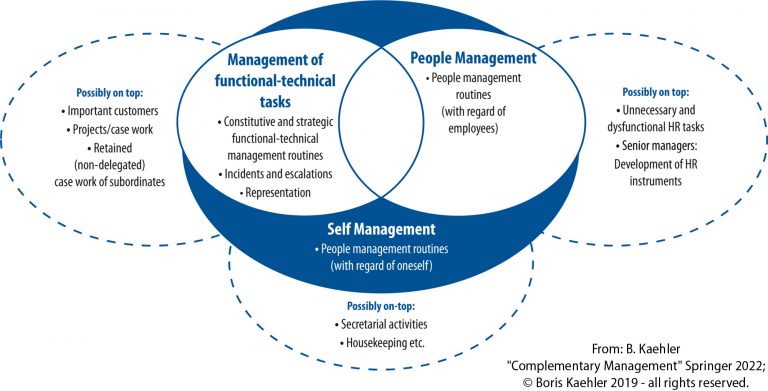Manager Development
Managing and leading is a profession. Various manager development measures are used to build up the corresponding elementary and action competencies. These include, in particular, management training and coaching as well as other methods, including career planning and executive selection. Corporate models of management and leadership can be understood as the metastructure of manager development.
Stipulating Concrete Responsibilities, Requirements and Competencies
High quality management and leadership cannot be achieved by means of selection and training alone, but through intelligent management structures and the stipulation of concrete responsibilities. If the organization does not provide a normative framework in the form of a meaningful corporate model of management, the Complementary Management Model can, if needed, serve as a direct point of reference. In fact, an implicit management model is thus introduced through the back door of manager development. It is true that individual line managers may benefit by orienting themselves to such standards; individual measures (e.g., training or coaching) can also be improved in this way. However, with a view to the organization as a whole, it is necessary to let these theoretical guiding principles run like a common theme through all measures. Only by referring back to them can selection and development measures be made consistent across the board and thus effective. This applies to selection procedures based on aptitude diagnostics as well as to training measures (initial training, refresher courses, in-depth training), to formalized feedback instruments, and to individual career support for line managers.
Management Routines as a Crystallization Point
The crystallization point of manager development efforts should be management routines as concrete activities (⇒ Implementation Elements). They serve to implement management tasks (⇒ Core Model). For example, performance feedback is initially only an abstract management task that has to be concretely implemented, primarily in regular employee dialogs. A distinction must be made between annual routines (e.g., annual employee reviews, team-building workshops), continuous routines (e.g., weekly work dialogs, team meetings) and on-demand routines (e.g., crisis interventions, disciplinary or conflict talks). The line manager’s share in the routines adds up to the totality of (only) their personnel management activities. In this way, management responsibility becomes very concrete: Did the line manager actually perform the routines incumbent upon him or her and achieve the defined management tasks in the process? If, for example, a line manager does not conduct regular work dialogs, he or she is simply neglecting his or her professional duties. The competence requirements for line managers, which form – or should form – the basis of manager development and selection, can be derived just as concretely.
The “Management as a Profession” Program
The seminar program “Management as a Profession” is offered in German by goodHR GbR in Berlin/Germany. It is designed for senior line managers in companies, government agencies and other organizations. The program comprises four two-day seminars at two-month intervals in the key areas of “understanding management”, “day-to-day management”, “management issues” and “management strategies”, Participants also receive three individual coaching sessions between the seminars. You can find more details about the program »here«.
Further Application Examples
Many organizations and consultants/trainers already work with the Complementary Management Model. One example is the innovative leadership concept of pt-training, a tool made up of online and offline elements. You can find more about it »here«.

